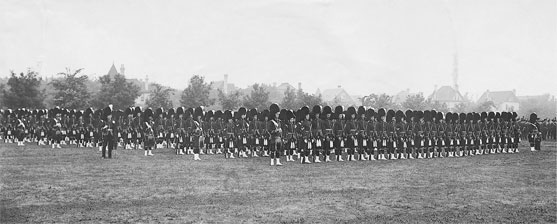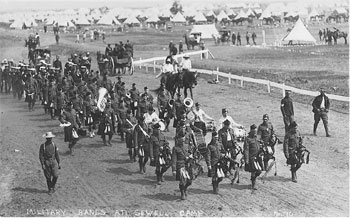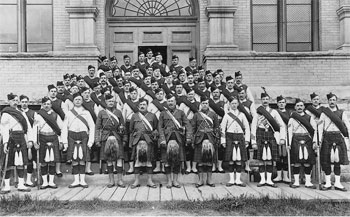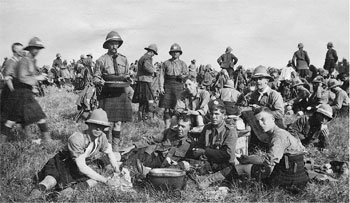 |
|
Kit Shop | Downloads | Links | Site Map | Contact Us |
|
A Highland Regiment for Winnipeg 1910-1914
On 1 February 1910 the 79th Cameron Highlanders of Canada came into existence. This, Western Canada's first highland regiment, was the result of persistent efforts by Winnipeg�s Scottish community. The first Scots in Manitoba were the employees and officers of the Hudson�s Bay and Northwest Fur Trading Companies. The Selkirk settlers, the original colonists of the Red River settlement, were Scots. Retired fur-traders, many from the Orkneys, joined those who had settled along the Red and Assiniboine Rivers and formed a healthy and active Scottish community. The Cameron Highlanders were raised during a time of patriotic zeal for the British Empire, and in recognition for the need of Canada to develop its own defense forces. Many Winnipeg Scots had served in the Northwest Rebellion and the Boer War. The Scottish community therefore found itself with a pool of proud and soldierly men who wished to continue serving their country. The result was a rising demand for a Highland infantry regiment. As early as 1905 there had been talk of forming a Winnipeg Highland unit. On 20 October 1908 a committee formed of delegates from a variety of Scottish societies met at the Saint Andrews Society rooms in the old Manitoba Club. Their task was to lobby the federal government and gain approval for a kilted regiment in Winnipeg. On 29 September 1909 the prospective officers met and committees dealing with finances, uniforms and the band were formed. On 1 February 1910 the Regiment was officially gazetted, and headquarters were established in the former Dominion Lands Office at 202 Main Street. The availability of the number "79" was fortuitous and enabled the new Canadian regiment to emulate its namesake regiment in Scotland, originally the 79th (Cameron Highlanders) Regiment of Foot. This association with the imperial Camerons became official on 31 January 1911 when King George V authorized the affiliation of the two Highland regiments. The Regiment's first Honourary Colonel was Lord Strathcona and Mount Royal (Sir Donald A. Smith) GCMG, GCVO. His ties to the military and Scottish community of Winnipeg were extensive.
A highland regiment is not complete without its pipes and drums. Initially the band was small--eight pipers and three drummers, but the Regiment took over the brass band of the 18th Mounted Rifles and by 1913 their combined strength was 72. Another basic task was recruiting..."strict attention must be given to ensure that recruits fulfill the regimental requirements--viz they must be of good character--they must fulfill the regulation requirements as regards age and physique, and must be of Scottish birth or descent."
The regiment became associated with the Winnipeg Highland Cadet Battalion on 3 March 1914. Formed less then a year previously, the Cadet Battalion provided training in soldiering and citizenship for boys and young men. The cadet unit, latter known as Number 407, The Queens Own Cameron Highlander of Canada Cadet Battalion was a valuable source of recruits for the regiment.
Managing the Regiment was not without its problems. Among the most serious were manpower retention, missing kit, poorly fitting uniforms, a shortage of uniforms and equipment, lack of training and office space, and a shortage of money! Despite these difficulties, the success of the new venture can not be questioned. Raising of the Regiment was a successful undertaking thanks to dedicated leadership and community support. In only four short years the 79th Cameron Highlanders of Canada had evolved from a simple idea into the reality of over five hundred uniformed, equipped, well trained and enthusiastic volunteers. The outbreak of war may well have shocked them, but it did not catch them unprepared. They were, as their motto declares, "Ullamh,"-Ready! The Great War, 1914-1918 |
| © 2006 - The Queen's Own Cameron Highlanders of Canada |

 Funding a highland regiment was no small undertaking--an initial amount of $25,000.00 was raised, mainly by the Scottish societies and the officers. Some of this went to the basic outfitting of the rank and file, as the government grant did not cover the complete expense. Until February 1913 a $5.00 enrollment fee for other ranks helped defray expenses. In some years all pay was signed over to the regimental fund.
Funding a highland regiment was no small undertaking--an initial amount of $25,000.00 was raised, mainly by the Scottish societies and the officers. Some of this went to the basic outfitting of the rank and file, as the government grant did not cover the complete expense. Until February 1913 a $5.00 enrollment fee for other ranks helped defray expenses. In some years all pay was signed over to the regimental fund. On 9 October 1910 the Regiment received its first stand of Colours, presented by Mrs. D.C. Cameron, wife of the Honourary Lieutenant Colonel. Eight months later, on 22 June 1911 a contingent of 61 Camerons participated in the coronation of King George V. The Canadian Camerons made an impression on all who saw them: "The Dominion troops came down Lord Street with great swing, their general military bearing being much admired. The Canadian Cameronian (sic) Highlanders attracted profound attention. Two of their number were ...of giantesque proportion. From sole of foot to top of highland headgear the Winnipeg man stood eight feet high. He was brought up on porridge, and appeared almost to belong to a prehistoric age. Several companions did not lag much behind in point of height and girth."--Liverpool Daily Post 10 June 1911.
On 9 October 1910 the Regiment received its first stand of Colours, presented by Mrs. D.C. Cameron, wife of the Honourary Lieutenant Colonel. Eight months later, on 22 June 1911 a contingent of 61 Camerons participated in the coronation of King George V. The Canadian Camerons made an impression on all who saw them: "The Dominion troops came down Lord Street with great swing, their general military bearing being much admired. The Canadian Cameronian (sic) Highlanders attracted profound attention. Two of their number were ...of giantesque proportion. From sole of foot to top of highland headgear the Winnipeg man stood eight feet high. He was brought up on porridge, and appeared almost to belong to a prehistoric age. Several companions did not lag much behind in point of height and girth."--Liverpool Daily Post 10 June 1911. Theoretical and practical training took place on evenings and weekends and included instruction in weapons handling, first aide, field craft and drill. Shooting took place at St. Charles Range. More intensive training occurred during the summer, at Camp Sewell in 1912, 1913, and 1914.
Theoretical and practical training took place on evenings and weekends and included instruction in weapons handling, first aide, field craft and drill. Shooting took place at St. Charles Range. More intensive training occurred during the summer, at Camp Sewell in 1912, 1913, and 1914.